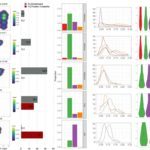Link to Pubmed [PMID] – 28317029
mSystems 2017 Mar-Apr;2(2)
As for many model organisms, the amount of Listeria omics data produced has recently increased exponentially. There are now >80 published complete Listeria genomes, around 350 different transcriptomic data sets, and 25 proteomic data sets available. The analysis of these data sets through a systems biology approach and the generation of tools for biologists to browse these various data are a challenge for bioinformaticians. We have developed a web-based platform, named Listeriomics, that integrates different tools for omics data analyses, i.e., (i) an interactive genome viewer to display gene expression arrays, tiling arrays, and sequencing data sets along with proteomics and genomics data sets; (ii) an expression and protein atlas that connects every gene, small RNA, antisense RNA, or protein with the most relevant omics data; (iii) a specific tool for exploring protein conservation through the Listeria phylogenomic tree; and (iv) a coexpression network tool for the discovery of potential new regulations. Our platform integrates all the complete Listeria species genomes, transcriptomes, and proteomes published to date. This website allows navigation among all these data sets with enriched metadata in a user-friendly format and can be used as a central database for systems biology analysis. IMPORTANCE In the last decades, Listeria has become a key model organism for the study of host-pathogen interactions, noncoding RNA regulation, and bacterial adaptation to stress. To study these mechanisms, several genomics, transcriptomics, and proteomics data sets have been produced. We have developed Listeriomics, an interactive web platform to browse and correlate these heterogeneous sources of information. Our website will allow listeriologists and microbiologists to decipher key regulation mechanism by using a systems biology approach.






